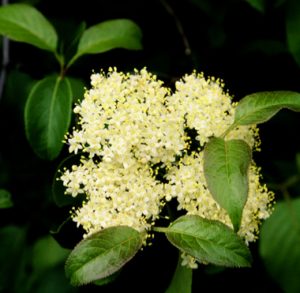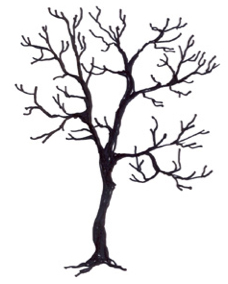Bulletin #2583, Native Trees and Shrubs for Maine Landscapes: Nannyberry Viburnum (Viburnum lentago)
Developed by Marjorie Peronto, Associate Extension Professor, University of Maine Cooperative Extension; and Reeser C. Manley, Assistant Professor of Horticulture, University of Maine.
For information about UMaine Extension programs and resources, visit extension.umaine.edu.
Find more of our publications and books at extension.umaine.edu/publications/.
Go native!
This series of publications is the result of a five-year research project that evaluated the adaptability of a variety of native trees and shrubs to the stresses of urban and residential landscapes in Maine. Non-native invasive plants pose a serious threat to Maine’s biodiversity. Plants such as Japanese barberry, shrubby honeysuckle, and Asiatic bittersweet, originally introduced for their ornamental features, have escaped from our landscapes, colonizing natural areas and displacing native plants and animals. By landscaping with native plants, we can create vegetation corridors that link fragmented wild areas, providing food and shelter for the native wildlife that is an integral part of our ecosystem. Your landscape choices can have an impact on the environment that goes far beyond your property lines.
Description
Form: a multi-stemmed shrub or small tree with upright, spreading branches that become arching
Size: 15 to 25 feet high, typically three-fourths as wide
Ornamental characteristics:
- broad, flat-topped terminal clusters of creamy white flowers in late May
- open, drooping terminal clusters of football-shaped berries, changing color from green to yellows and reds, and finally to black with a powder blue bloom, from early September through early December
Landscape Use
Nannyberry viburnum is an excellent shrub or small tree to plant in drier landscape sites. Consider using it in such sites with its native associates: black cherry (Prunus serotina), staghorn sumac (Rhus typhina), beaked filbert (Corylus cornuta), chokecherry (Prunus virginiana), and native hawthorns (Crataegus spp.). This collection of natives would make an excellent wildlife garden, with nannyberry viburnum serving as host to numerous species of songbirds, upland ground birds, and small mammals.
Viburnum lentago performs best in full sun; its foliage is sensitive to mildew in too much shade. It has proven itself to be tolerant of heat and drought and performs well in the urban landscape. It is sensitive to salt, however, so avoid using it near areas treated with deicing salts in winter.
You can manipulate the form of this viburnum by pruning. Left to its own, it often develops a shrubby habit with multiple trunks and upright spreading branches. It can be pruned, however, to a single trunk, as shown in the drawing.
Culture
Hardiness: USDA zone 2
Soil requirements: prefers moderately to well-drained soils
Light requirements: full sun
Stress tolerances:
soil compaction — intolerant
pollution — tolerant
deicing salts — intolerant
urban heat islands — tolerant
drought — tolerant
seasonal flooding — intolerant
Insect and disease problems: infrequent
Wildlife Value
The foliage of nannyberry viburnum is host to several moth caterpillars, including two owlet moths: the unsated sallow and the horrid zale. Chief feeders of viburnum fruits include ruffed grouse, brown thrashers, cedar waxwings, eastern chipmunks, and red squirrels. In general, fruits of most viburnums are low in fat, and thus seldom taken in great abundance.
Maintenance
Irrigation: Water shrubs regularly for at least one year after planting. Apply 1 inch of water over the root zone once a week until leaves fall in autumn: in general, a shrub’s root zone extends twice as wide as its canopy. Once plants are established, further watering should not be necessary unless there are extended periods of drought.
Fertilization: Landscape trees and shrubs should not be fertilized unless a soil test indicates a need. Correct soil pH, if necessary, by amending the backfill soil. No nitrogen fertilizer should be added at planting or during the first growing season.
To learn more about native woody plants
Visit the Eastern Maine Native Plant Arboretum at University of Maine Cooperative Extension’s Penobscot County office, 307 Maine Avenue in Bangor. Established in 2004, the arboretum displays 24 different native tree and shrub species that can be used in managed landscapes.
Reviewed by Cathy Neal, Extension professor, University of New Hampshire Cooperative Extension.
Photos by Reeser C. Manley.
Illustration by Margery Read, Extension Master Gardener.
This series of publications and the associated research were made possible in part by the Maine Forest Service’s Project Canopy.
Information in this publication is provided purely for educational purposes. No responsibility is assumed for any problems associated with the use of products or services mentioned. No endorsement of products or companies is intended, nor is criticism of unnamed products or companies implied.
© 2008
Call 800.287.0274 (in Maine), or 207.581.3188, for information on publications and program offerings from University of Maine Cooperative Extension, or visit extension.umaine.edu.
In complying with the letter and spirit of applicable laws and pursuing its own goals of diversity, the University of Maine System does not discriminate on the grounds of race, color, religion, sex, sexual orientation, transgender status, gender, gender identity or expression, ethnicity, national origin, citizenship status, familial status, ancestry, age, disability physical or mental, genetic information, or veterans or military status in employment, education, and all other programs and activities. The University provides reasonable accommodations to qualified individuals with disabilities upon request. The following person has been designated to handle inquiries regarding non-discrimination policies: Director of Equal Opportunity and Title IX Services, 5713 Chadbourne Hall, Room 412, University of Maine, Orono, ME 04469-5713, 207.581.1226, TTY 711 (Maine Relay System).





